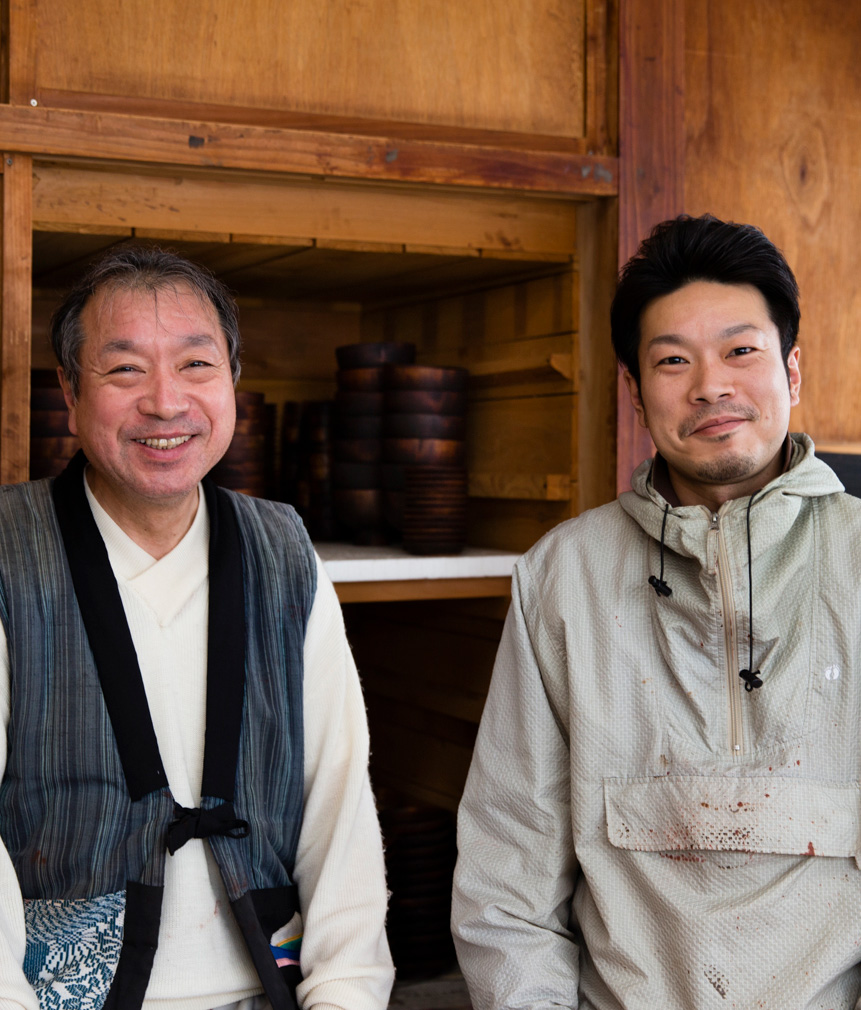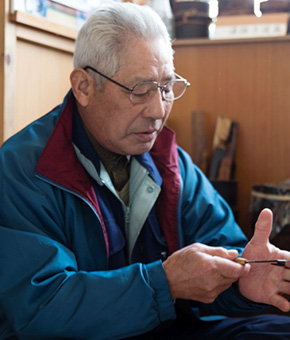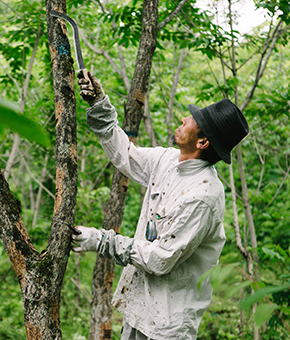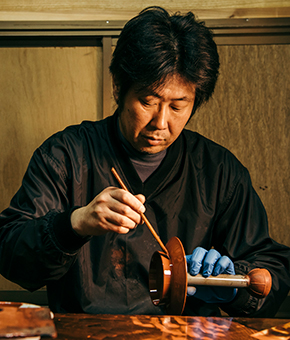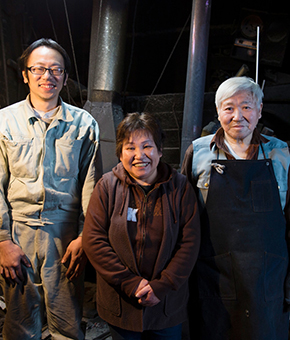Keep making the lacquerware for everyday use
Urushi Tapper and Lacquer painter
Ms. Namiko Yamazaki
Attracted to Urushi encountered in the classroom
The matte liquid placed on the wooden base becomes glossy as the time passes by. And the gloss shines further, and the gain underneath it shines brilliantly…
This is how Ms. Yamazaki first saw Urushi. At a traditional craft class of her community college, she tried wipe-lacquering. “At first I didn’t feel anything about it, but when I go back to think about it, that is how it was.” Although still a student, her sense discovered the charm of Urushi. She went to the school interested in the interior design, but this became the turning point, and as the class continued she was more and more attracted to Urushi. By the time of graduation, she knew she was going to proceed to be a lacquer painter.
If I could lacquer the Urushi I tapped
After graduation, she became the trainee of the “Ashiro Town Lacquerware Center (now called: Ashiro Lacquer Art Technology Research Center)” in the town of Ashiro (now Hachimantai City), historically related to Joboji and Urushi, and learned Urushi from scratch. She also learned how to make the spatula, and various techniques of painting, and experienced purification of Urushi and Sugurome Urushi (purified Urushi in black). The techniques she learned was much different from what she learned in the class of her community college.
Then she started working for Tekiseisha. Although she already had enough skill to produce lacquerware by herself, she began with priming and middle coating. Gradually, she took charges in the top coating that requires skilled techniques, and after a while, she came to specialize in the top coating.
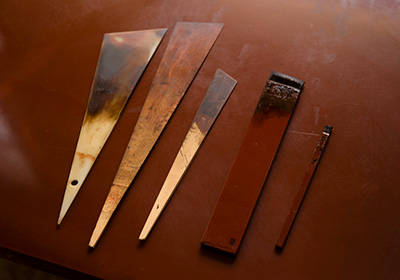
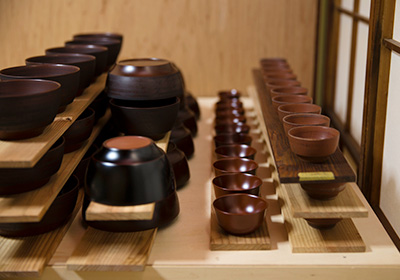
Lacquerware in production, waiting for the next process.
As she only had to work about half a month, she also did some works for herself. It was when she was in Tekiseisha when her first designed product was sold. It was a soup bowl in vermillion and dark brown, resized to 4-sun (approx. 12cm) from the 6-sun which she made for her graduation project.
In the 11th spring of the year, since Ms. Yamazaki has started working in the Urushi field, she launched “Urushi Kobo Yamanami.” She had to prepare her own tools which she used to borrow and spent some time economically unstable, but after about 3 years, she was able to make room for herself. Then she decided to go into urushi tapping.
Tough work facing Lacquer
“Tapping” work is harsh. During the season – from June to about mid-November, she goes into the mountain day after day from early morning. Ms. Yamazaki starts her work in the mountains at 5 am. She gets up at 3 am to 4 am, considering the preparation and the transportation from home to the site. With this kind of life, she can’t do lacquering while tapping. Ms. Yamazaki says, “I never thought I would go into tapping,” but she gradually, “wished to use the lacquer I went to scrape,” and she applied for the long-term training program conducted by Japanese urushi tapping Preservation Society.
In order to take the lacquer, scratch the trunk with a lacquer plane after trimming the bark of the trunk with a bark-removing sickle, the process called “Kamazuri.” If the scratch is not made well, the tree will not provide the sap. According to the condition of the tree, various adjustments such as angle of the lacquer plane, depth to slice in, and the length of the scratch, are required. The work is to the extent that, “You can’t hold your hands with only Kamazuri.”
Once the sap is coming out, take each drop with a spatula and place it into a container called Takappo. “Trees also have seasons, and they provide more saps when they are on. But if you work slowly, the saps will go in between the barks, and you can’t get it anymore,” says Ms. Yamazaki. Sometimes the Urushi goes onto the face. Also, she can’t work on rainy days, has to come back if it starts raining when she goes to the mountains and goes back in again once it stops raining… However, it is more important for her to feel the difficulty and fun or the work or the daily weather, instead of feeling fear for the danger and risks.
There are no women that work as a lacquer-tapper, even though some have come for training. She hasn’t changed her mind to continue lacquer-tapping, but with only one training she is still uncertain about being her own. The first lacquer she tapped is “still under moving stage,” so not yet purified, but she plans to do so soon. We are excited about this Urushi, what type of characters it may have.
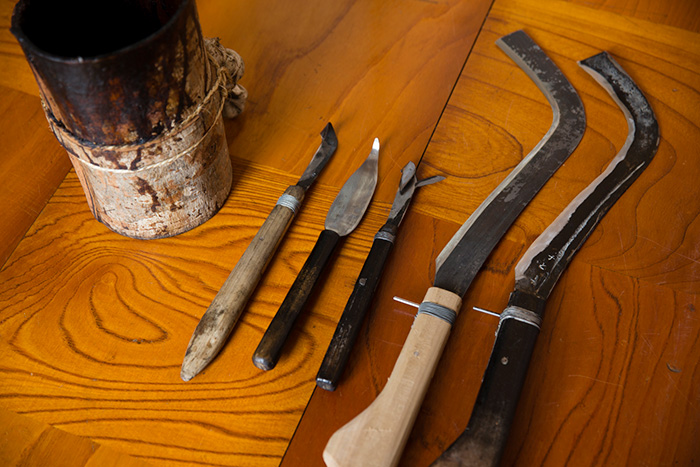
Lacquer-tapping Kit for Beginners. From the right, bark-removing sickles (2pcs), Urushi plane to make scratches, spatula to take the sap, Eguri to use when the bark is hard (Urame-kaki), and Takappo to pour the Urushi.
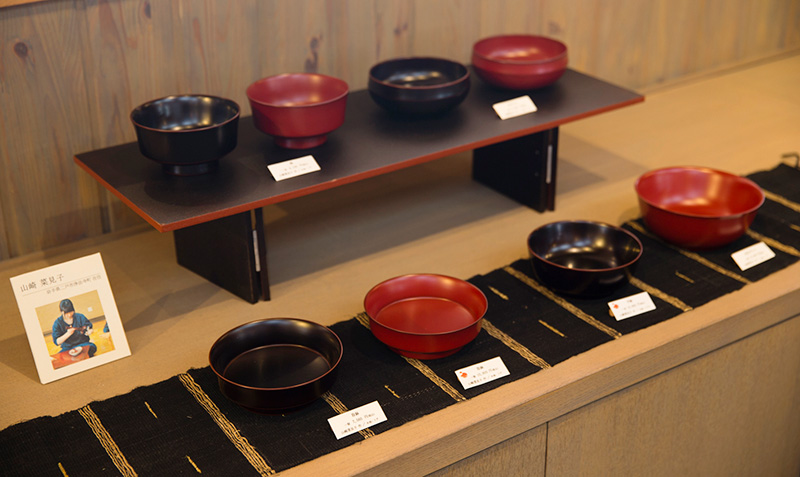
There is a corner in Sekiseisha shop to show works of Ms. Yamazaki.
A unique technique as the lacquer painter of the production area
The charms of Urushi as a lacquer painter is that it “changes in different seasons, even when using the same lacquer.” Her words are simple, but when she says the work is “decided to look at the weather and humidity”, and she “knows who tapped the Urushi she is using”, we can see that she is highly skilled in knowing the delicacy and variety of the lacquer, and the judgment skill required for a lacquer painter. “I look at the character of the Urushi, and sometimes I mix them to use.” She begins. The lacquer purchased from vendors is constant in quality, but the lacquer painters in Joboji purchase the lacquer from the tapper directly and purifies it themselves so the conditions of the lacquer changes. She looks fascinated, “We can do this only in the production area.” This is probably because she is truly in love with Joboji.
The works of Ms. Yamazaki focus on soup bowls, small bowls, and cups – things you use every day. The lead time from the arrival of the wooden base to shipment is approximately 3 months. The top coating is “One-shot,” even a piece of dust floating in the air will be a problem.
She will keep on making the lacquerware for daily use. “I would be happy if the buyers like my products and use them,” her warm feeling for Urushi and its users motivate her work.
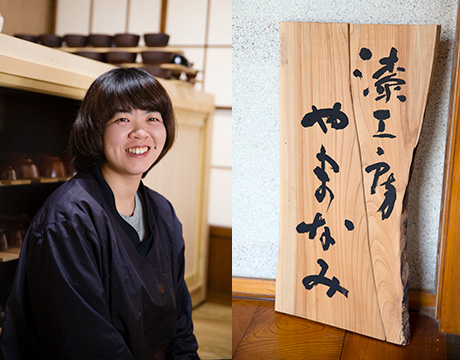
Yamazaki, producing a lacquer-ware in a detached house of “Lacquer studio Yamanami.” The studio sign that was given when he became independent.

